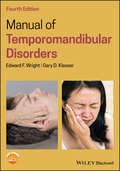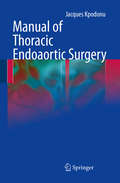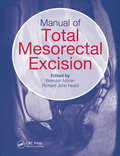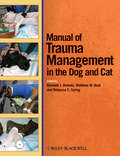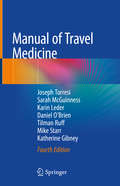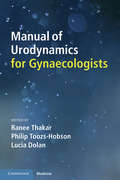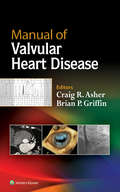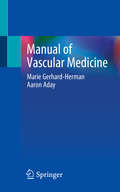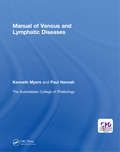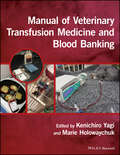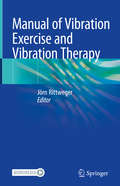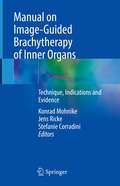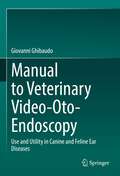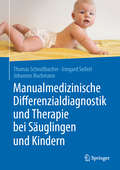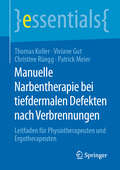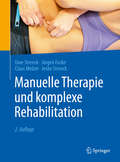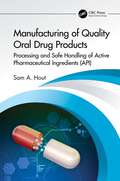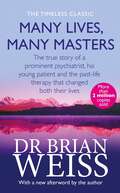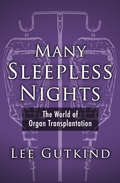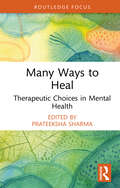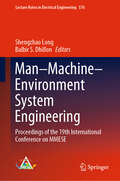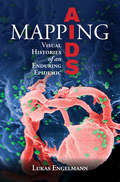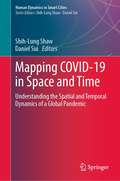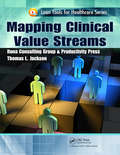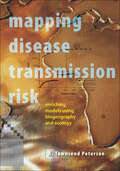- Table View
- List View
Manual of Temporomandibular Disorders
by Edward F. Wright Gary D. KlasserFully updated with the latest information in the field, this comprehensive book provides a practical guide to diagnosing and managing temporomandibular disorders in the dental practice. Written in an accessible, user-friendly style, it offers a simplified approach to the basic concepts and management decision points for the most commonly observed temporomandibular conditions, integrating the latest advances and advice throughout. Quick Consult, Focal Point, and Technical Tip boxes provide quick access to relevant information, and study results are summarized in graphs for ease of comprehension. Manual of Temporomandibular Disorders, Fourth Edition examines an array of medical and dental conditions that affect the temporomandibular joint (TMJ), masticatory muscles, and contiguous structures. It presents evidence-based, clinically practical information to help dentists diagnose TMD accurately, rule out disorders that mimic TMD, and provide effective therapy for most patients. Special features include: Frequently Asked Questions Quick Consults, Technical Tips, and Focal Points Information on disorders that mimic TMD and factors that warrant referral Extensive color photographs and line drawings A companion website providing helpful examples and patient handouts Manual of Temporomandibular Disorders, Fourth Edition is a must-have how-to manual for general dentists, dental students, and residents involved in this area of practice.
Manual of Thoracic Endoaortic Surgery
by Jacques KpodonuThere is currently no standard manual for easy reference that is pocket sized and easy to read prior to planning such a case. The manual will also be a simple reference guide for residents, fellows in cardiovascular interventions as well as device representatives from Medtronic, Cook, Gore and Bolton.
Manual of Total Mesorectal Excision
by Brendan Moran Richard John HealdManual of Total Mesorectal Excision is the authoritative manual for the trainee and qualified surgeon, covering every aspect of total mesorectal excision for rectal cancer.Written by the surgeons who pioneered and popularized TMEIncludes high-quality colour illustrations to detail the multidisciplinary management of rectal cancerEndorsed by the Pel
Manual of Trauma Management in the Dog and Cat
by Kenneth J. Drobatz Matthew W. Beal Rebecca S. SyringManual of Trauma Management in the Dog and Cat provides quick access to clinically relevant information on stabilizing, diagnosing, and managing the trauma patient. The book uses an outline format to provide fast access to essential information, focusing on practical advice and techniques for treating traumatic injuries. Manual of Trauma Management in the Dog and Cat is an ideal handbook for quickly and confidently managing this common presenting complaint. Beginning with a concise summary of the global assessment of traumatized patients, the heart of the book is devoted to guidance on managing specific types of trauma following definitive diagnosis. Manual of Trauma Management in the Dog and Cat is a valuable quick-reference guide to treating canine and feline trauma patients for general practitioners and emergency specialists alike.
Manual of Travel Medicine: A Pre-travel Guide For Health Care Practitioners
by Joseph Torresi Sarah McGuinness Karin Leder Daniel O’Brien Tilman Ruff Mike Starr Katherine GibneyThe fourth edition of this well received book provides an authoritative and up-to-date resource to support good practice in travel medicine, a field that has evolved substantially in recent years. Concretely, there has been intensified monitoring of health problems among travelers, as well as extensive research efforts, which have led to the development of evidence-based approaches to the field. The book includes expert recommendations regarding e.g. immunizations, malaria prophylaxis, travelers’ diarrhea, altitude sickness, emerging infections, and non-infectious health issues encountered by travelers. It provides a practical approach to the pre-travel consultation and management of most issues that arise in medical care for travelers. In addition, it provides expert advice for high-risk travelers, e.g. those with immunosuppression, the elderly, pregnant women and young children. The text offers a user-friendly, practical handbook for healthcare practitioners during their clinical consultations, as well as nurses and pharmacists.
Manual of Urodynamics for Gynaecologists
by Philip Ranee Thakar Lucia Dolan Toozs-HobsonThis manual is a concise, straightforward guide for learning how to perform high-quality urodynamic investigations. Experienced editors and contributors provide easy-to-follow practical information on pre-test assessment of urodynamic function, how to set up urodynamic equipment, and how to perform individual urodynamic techniques, including cystometry, videocystourethrography and ambulatory monitoring. The book covers modern equipment and its use, and outlines the new national standards in urodynamics, allowing readers to check their knowledge and standard operating procedures are adequate. It also gives valuable information on how to set up and run a urodynamics service. With clear illustrations and clinical case studies woven into the text, this is a must-have resource to facilitate training in urodynamics. It is also a refresher of the standards and protocols required for good urodynamic practice for gynaecologists and continence nurses.
Manual of Valvular Heart Disease
by Craig R. Asher Brian P. GriffinPortable and clinically oriented, this full-color handbook is a unique and timely guide to valvular heart disease and percutaneous coronary interventions. A structured, standardized format helps you quickly find the information you need, while numerous illustrations and videos online provide visual support for key concepts and procedures.
Manual of Vascular Medicine
by Marie Gerhard-Herman Aaron AdayThis practical manual makes clinical vascular medicine easy for the health care provider to master by providing frameworks for each area of diagnosis and a practical approach to necessary testing. Rather than providing long lists of possible diagnoses for a clinical question, each approach is broken down into a flow chart of the thinking and questions necessary so that only those needed in each situation are utilized. Chapters cover a broad range of topics including arterial and venous testing in the laboratory, thrombophilia, cold disorders of the extremities and lymphatic diseases. Manual of Vascular Medicine provides extensive case-based learning for trainees and practicing physicians looking to expand their knowledge in this field that crosses many traditional disciplines. It is therefore of importance to any medical professional managing vascular patients, including cardiovascular and vascular physicians, nephrologists, neurologists, phlebologists, dermatologists, general medical doctors and vascular radiologists.
Manual of Venous and Lymphatic Diseases
by Australasian College of PhlebologyThe Manual of Venous and Lymphatic Diseases constitutes a concise but comprehensive and contemporary description of the nature and management of venous and lymphatic diseases. This innovative book instructs the post-graduate trainee in phlebology and is also valuable to undergraduate students wishing to gain a broader knowledge than is available in general surgical texts. Addtionally, it is a useful reference for practising phelebologists, vascular surgeons and imaging specialists. The text covers basic principles, diagnosis and treatment of chronic venous disease, venous thrombo-embolism, lymphoedema and vascular malformations.
Manual of Veterinary Transfusion Medicine and Blood Banking
by Kenichiro Yagi Marie HolowaychukUsing a practical approach, the Manual of Veterinary Transfusion Medicine and Blood Banking provides veterinary practitioners with evidence-based guidelines to refer to at the clinical practice level. Provides evidence-based information on transfusion medicine and blood banking practices Presents sections on recipient screening, donor selection, blood collection and storage, and how to meet blood product demands Includes useful protocols for transfusions and blood banking relevant to clinical practice Incorporates the balanced perspectives of veterinarians and veterinary technicians Contains information pertaining to large, small, and exotic animals
Manual of Vibration Exercise and Vibration Therapy
by Jörn RittwegerThis book addresses the practical aspects of vibration exercise and vibration therapy. In addition, it describes the technical and physiological background, providing applied scientists and doctors with a deeper understanding of the therapeutic potential that vibration exercise holds. Having first emerged two decades ago, vibration exercise has since established itself as a widespread form of physical exercise, used in all rehabilitation areas. The goal of this book is to close the gap between scientific knowledge and practice.Given that occupational exposure to vibration leads to well-known unfavorable effects, the book is also dedicated to potential risks, hazards and contra-indications and of course, the application of vibration therapy in a number of specific conditions is presented in a clinically usable fashion. Given its breadth of coverage, this book will be of interest to physiotherapists and exercise scientists, but also to a wider range of physicians working in the field of rehabilitation.
Manual on Image-Guided Brachytherapy of Inner Organs: Technique, Indications and Evidence
by Jens Ricke Konrad Mohnike Stefanie CorradiniThis book provides a comprehensive insight into this special form of image-guided interventional therapy and its indications. It begins by introducing the fundamental principles of radiotherapy, the most up-to-date guidelines and the interdisciplinary aspects of the technique and then expands to more practical aspects such as therapy planning, indications and the use of the technique for certain tumor types, including liver metastases, rare tumors, cerebral malignancies and prostate tumors.Written and edited by pioneers in this technique, the chapter’s outline results and numerous illustrated case studies from the daily routine of daily clinical practice providing an insightful guidance to this relatively new but growing method.This is an indispensable guide for oncologists, radiation therapists and radiologists, but also general practitioners and all other specialties, which have an oncological focus.
Manual to Veterinary Video-Oto-Endoscopy: Use and Utility in Canine and Feline Ear Diseases
by Giovanni GhibaudoThis atlas provides a step-by-step manual in using the video-oto-endoscope (VOE) as a tool to study ear diseases in cats and dogs. Illustrated by numerous high-resolution images and case studies, the book explains in a highly accessible manner when and how to use VOE. It teaches how to differ between a normal and a pathological animal ear and guides the reader in diagnosing a particular disease. The book's main section provides in-depth information on causes, clinical picture, and imaging of ear diseases such as acute otitis externa, chronic otitis externa, and otitis media in small animals. Moreover, the atlas introduces technical fundamentals of the instrument and gives tips for its correct handling and cleaning. Further, readers are instructed on how to best prepare the animal patient for examination by VOE. The atlas addresses veterinary practitioners and veterinary technicians who are interested in performing otological examinations in cats and dogs.
Manualmedizinische Differenzialdiagnostik und Therapie bei Säuglingen und Kindern
by Johannes Buchmann Irmgard Seifert Thomas SchnellbacherSchwerpunkt des Buches ist die Differenzialdiagnostik und Therapie der manualmedizinischen Störungen bei Säuglingen und Kindern. Damit setzt es die „Praxis der Manuellen Medizin bei Säuglingen und Kindern“ (Seifert I, Schnellbacher T, Buchmann J (2017) Springer, Heidelberg) fort, in dem ausführlich die Techniken der manualmedizinisch-osteopathischen Untersuchung und Behandlung bei Säuglingen und Kindern im Kleinkind- und Schulalter beschrieben werden.Zu Beginn einer Untersuchung ist eine exakte Differenzialdiagnose notwendig, um strukturelle Ursachen vor Behandlungsbeginn auszuschließen. Alarmsignale, die auf strukturelle Erkrankungen hinweisen, müssen Manualtherapeuten kennen und erkennen können.Bei der Auswahl der Krankheitsbilder ging es dem Autorenteam nicht um Vollständigkeit, sondern um die manualmedizinische Sichtweise: gedacht wird in Funktionsketten und es gilt herauszufinden, wann und auf welche Weise Verkettungen stattfinden. Erst dann wird die Behandlungsstrategie festgelegt.Darüber hinaus gilt bei der Behandlung von Kindern als Besonderheit, dass die ablaufenden Wachstums- und Entwicklungsprozesse berücksichtigt werden müssen.
Manuelle Narbentherapie bei tiefdermalen Defekten nach Verbrennungen: Leitfaden für Physiotherapeuten und Ergotherapeuten (essentials)
by Patrick Meier Thomas Koller Viviane Gut Christine RüeggDieses essential liefert Physio- und Ergotherapeuten einen Überblick über die manuelle Therapie von Verbrennungsnarben. Kompression, Schienenversorgung und der zielgerichtete Einsatz von Silikon schulen den Therapeuten für bestmögliche Ergebnisse. Befundaufnahme, Behandlungstechniken und individuell an die Wundheilungsphasen angepasste Dosierungen vervollständigen die notwendigen Kompetenzen.
Manuelle Therapie und komplexe Rehabilitation
by Uwe Streeck Jürgen Focke Claus Melzer Jesko StreeckDieses Praxisbuch zeigt Physiotherapeuten, wie sie gezielt umfassende und wirkungsvolle Behandlungskonzepte für ihre Patienten erstellen. Die Autoren beschreiben einen klar strukturierten Therapieleitfaden mit Befund- und Behandlungsmöglichkeiten für jede Körperregion. Lernen Sie, wie Sie klassische und neue Techniken aus der Manuellen Therapie mit physikalischen und trainingstherapeutischen Maßnahmen sinnvoll kombinieren. Dieses Buch bietet wesentliche Hintergrundinformationen zu jeder Körperregion und erklärt die Anatomie, die Biomechanik, die Pathologie und klinische Besonderheiten. Erfahren Sie alles zur genauen Befunderhebung mithilfe der Anamnese, der Inspektion, der Palpation, Funktionstests und Tests zur Differenzialdiagnostik. Ein umfangreiches Spektrum an Behandlungsmöglichkeiten, wie Mobilisations- und Manipulationstechniken, Nervenmobilisation, Aufbautraining, Injektionstechniken, sportartspezifische Rehabilitationsprogramme und Eigenübungen für Patienten bietet viele Ansätze für eine erfolgreiche Behandlung. Neu in der 2. aktualisierten Auflage sind zusätzliche Behandlungsmöglichkeiten bei HWS- und Schulterbeschwerden, ein Rehabilitationsprinzip für Bandscheibenvorfälle und neue Testverfahren.
Manufacturing of Quality Oral Drug Products: Processing and Safe Handling of Active Pharmaceutical Ingredients (API)
by Sam A. HoutThis book provides an understanding of what is required to engineer and manufacture drug products. It bridges established concepts and provides for a new outlook by concentrating and creating new linkages in the implementation of manufacturing, quality assurance, and business practices related to drug manufacturing and healthcare products. This book fills a gap by providing a connection between drug production and regulated applications. It focuses on drug manufacturing, quality techniques in oral solid dosage, and capsule filling including equipment and critical systems, to control production and the finished products. The book offers a correlation between design strategies and a step-by-step process to ensure the reliability, safety, and efficacy of healthcare products. Fundamentals of techniques, quality by design, risk assessment, and management are covered along with a scientific method approach to continuous improvement in the usage of computerized manufacturing and dependence on information technology and control operations through data and metrics. Manufacturing and Quality Assurance of Oral Pharmaceutical Products: Processing and Safe Handling of Active Pharmaceutical Ingredients (API) is of interest to professionals and engineers in the fields of manufacturing engineering, quality assurance, reliability, business management, process, and continuous improvement, life cycle management, healthcare products manufacturing, pharmaceutical processing, and computerized manufacturing.
Many Lives, Many Masters: The true story of a prominent psychiatrist, his young patient and the past-life therapy that changed both their lives
by Dr. Brian WeissTHE CLASSIC BESTSELLER ON A TRUE CASE OF PAST-LIFE TRAUMA AND PAST-LIFE THERAPY FROM AUTHOR AND PSYCHOTHERAPIST DR BRIAN WEISSPsychiatrist Dr Brian Weiss had been working with Catherine, a young patient, for eighteen months. Catherine was suffering from recurring nightmares and chronic anxiety attacks. When his traditional methods of therapy failed, Dr Weiss turned to hypnosis and was astonished and sceptical when Catherine began recalling past-life traumas which seemed to hold the key to her problems. Dr Weiss's scepticism was eroded when Catherine began to channel messages from 'the space between lives', which contained remarkable revelations about his own life. Acting as a channel for information from highly evolved spirit entities called the Masters, Catherine revealed many secrets of life and death. This fascinating case dramatically altered the lives of Catherine and Dr Weiss, and provides important information on the mysteries of the mind, the continuation of life after death and the influence of our past-life experiences on our present behaviour.
Many Sleepless Nights: The World of Organ Transplantation
by Lee GutkindWinner of the American Heart Association&’s Howard W. Blakeslee Award for outstanding achievement in scientific journalism: Lee Gutkind&’s riveting and groundbreaking account of the science, ethics, and life-changing capacity of organ transplantationOver the past six decades, the rapid advances in transplant surgery rank among the most impressive and significant in modern human history. But the procedures, which have an astonishing power to improve or even save lives, are often fraught with an unrivaled level of complexity. Seeking to better understand the world of transplant surgery, Lee Gutkind embedded himself for four years in the University of Pittsburgh&’s Presbyterian-University and Children&’s Hospitals, one of the largest transplant centers in the world. He got to know the doctors, researchers, patients, and families involved, while also exploring the history of transplantation and the often insoluble ethical quandaries it poses.Mesmerizing and unforgettable, Many Sleepless Nights depicts with uncanny insight the tremendous effort, suffering, and fortitude of the individuals whose lives have been changed forever by organ transplantation.
Many Ways to Heal: Therapeutic Choices in Mental Health
by Prateeksha SharmaThis book creates a scope for achieving mental wellbeing apart from the currently dominant mental health practices, critiqued for their damaging effects on individuals and families. By broadly drawing on salutary possibilities, it brings evidence of existing and emerging approaches to resolve mental distress. The unique volume brings several practices and testimonies together that can support people’s healing and recovery, focusing on the following key interventions: Different ways of looking at emotional suffering beyond psy-knowledge, which many doctors, social workers, disability scholars, legal or policy experts and psy-professionals advocate for The role of expressive arts employed by both professionals and peers Efficacy of peer engagement of a professional nature in India, the newest globally emerging phenomenon, often heralded as the future of mental health worldwide Deftly interwoven with patient and peer narratives in jargon-free language, this one-of-a-kind book brings practices and choices that can facilitate healing and ways out of permanent psychiatric patient-hood. This volume may be of interest to psychiatric and other helping professionals, therapists, researchers, current patients, caregivers, service providers, social workers, non-profits, students of psychology, social work and disability studies, as well as legal and policy experts.
Man–Machine–Environment System Engineering: Proceedings of the 19th International Conference on MMESE (Lecture Notes in Electrical Engineering #576)
by Balbir S. Dhillon Shengzhao LongThese proceedings showcase the best papers selected from more than 500 submissions, and introduce readers to the latest research topics and developmental trends in the theory and application of MMESE. The integrated research topic Man–Machine–Environment System Engineering (MMESE) was first established in China by Professor Shengzhao Long in 1981, with direct support from one of the greatest modern Chinese scientists, Xuesen Qian. In a letter to Long from October 22nd, 1993, Qian wrote: “You have created a very important modern science and technology in China!”MMESE studies the optimum combination of man–machine–environment systems. In this system, “man” refers to the people in the workplace (e.g. operators, decision-makers); “machine” is the general name for any object controlled by man (including tools, machinery, computers, systems and technologies), and “environment” describes the specific working conditions under which man and machine interact (e.g. temperature, noise, vibration, hazardous gases, etc.). The three main goals of optimizing man–machine–environment systems are to ensure safety, efficiency and economy.These proceedings present interdisciplinary studies on concepts and methods from physiology, psychology, system engineering, computer science, environmental science, management, education, and other related disciplines. They offer a valuable resource for all researchers and professionals whose work involves interdisciplinary areas touching on MMESE subjects.
Mapping AIDS: Visual Histories of an Enduring Epidemic (Global Health Histories)
by Lukas EngelmannIn this innovative study, Lukas Engelmann examines visual traditions in modern medical history through debates about the causes, impact and spread of AIDS. Utilising medical AIDS atlases produced between 1986 and 2008 for a global audience, Engelmann argues that these visual textbooks played a significant part in the establishment of AIDS as a medical phenomenon. However, the visualisations risked obscuring the social, cultural and political complexity of AIDS history. Photographs of patients were among the earliest responses to the mysterious syndrome, cropped and framed to deliver a visible characterisation of AIDS to a medical audience. Maps then offered an abstracted image of the regions invaded by the epidemic, while the icon of the virus aspired to capture the essence of AIDS. The epidemic's history is retold through clinical photographs, epidemiological maps and icons of HIV, asking how this devastating epidemic has come to be seen as a controllable chronic condition.
Mapping COVID-19 in Space and Time: Understanding the Spatial and Temporal Dynamics of a Global Pandemic (Human Dynamics in Smart Cities)
by Daniel Sui Shih-Lung ShawThis book describes the spatial and temporal perspectives on COVID-19 and its impacts and deepens our understanding of human dynamics during and after the global pandemic. It critically examines the role smart city technologies play in shaping our lives in the years to come. The book covers a wide-range of issues related to conceptual, theoretical and data issues, analysis and modeling, and applications and policy implications such as socio-ecological perspectives, geospatial data ethics, mobility and migration during COVID-19, population health resilience and much more. With accelerated pace of technological advances and growing divide on political and policy options, a better understanding of disruptive global events such as COVID-19 with spatial and temporal perspectives is an imperative and will make the ultimate difference in public health and economic decision making. Through in-depth analyses of concepts, data, methods, and policies, this book stimulates future studies on global pandemics and their impacts on society at different levels.
Mapping Clinical Value Streams (Lean Tools for Healthcare Series)
by Thomas L. JacksonTens of thousands of patients die unnecessarily every year as a result of errors and defects in our healthcare processes. Those that survive often pay too much for the privilege. The value stream mapping methods described in Mapping Clinical Value Streams will help you achieve more efficient health care processes and will pave the way to an improved medical system with significantly reduced medical errors and other costly waste.Part of the Lean Tools in Healthcare series, this user-friendly book will help you understand how to use value stream mapping to provide quality, patient-centered care. Value stream mapping is a powerful tool for observing and depicting processes as they truly are and for envisioning and reconfiguring the same processes to eliminate errors and other waste. With this book, you‘ll learn how to:Map current-state processesCreate a future-state map with processes streamlined through flow and pullManage the rollout of your future state with A3 project plansPresented in a highly organized and easy-to-assimilate format, the book includes examples from actual healthcare processes, plus numerous illustrations and margin assists that call your attention to key points. Value stream mapping icons make it easy to see and understand the ebb and flow of healthcare processes. Each chapter also includes a summary for quick review. Throughout the book you will be asked to reflect on questions that will help you apply these concepts and techniques to your own workplace.To be competitive in today‘s marketplace, you cannot afford to leave processes unexamined, or let them become haphazard. You must apply conscious, quality attention to continuously see and fix your healthcare processes. In Mapping Clinical Value Streams, Shingo Prize-winning author Thomas L. Jackson shows you how.
Mapping Disease Transmission Risk: Enriching Models Using Biogeography and Ecology
by A. Townsend PetersonA revolutionary book that presents analytical tools for understanding why a particular disease is transmitted within a specific geographic area.A. Townsend Peterson, one of the pioneers of ecological niche modeling, presents a synthesis that illuminates new and more effective infectious disease mapping methods. His work—the culmination of twelve years of refinement—breaks new ground by integrating biogeographic and ecological factors with spatial models. Aimed at seasoned epidemiologists and public health experts, this interdisciplinary book explains the conceptual and technical underpinnings of Peterson’s approach while simultaneously describing the potentially enormous benefits of his modeling method.Peterson treats disease transmission areas for what they are—distributions of species. The book argues that complex, fragmented, and highly irregular disease patterns can only be understood when underlying environmental drivers are considered. The result is an elegant modeling approach that challenges static spatial models and provides a framework for recasting disease mapping. Anyone working in the area of disease transmission, particularly those employing predictive maps, will find Peterson’s book both inspiring and indispensable.
